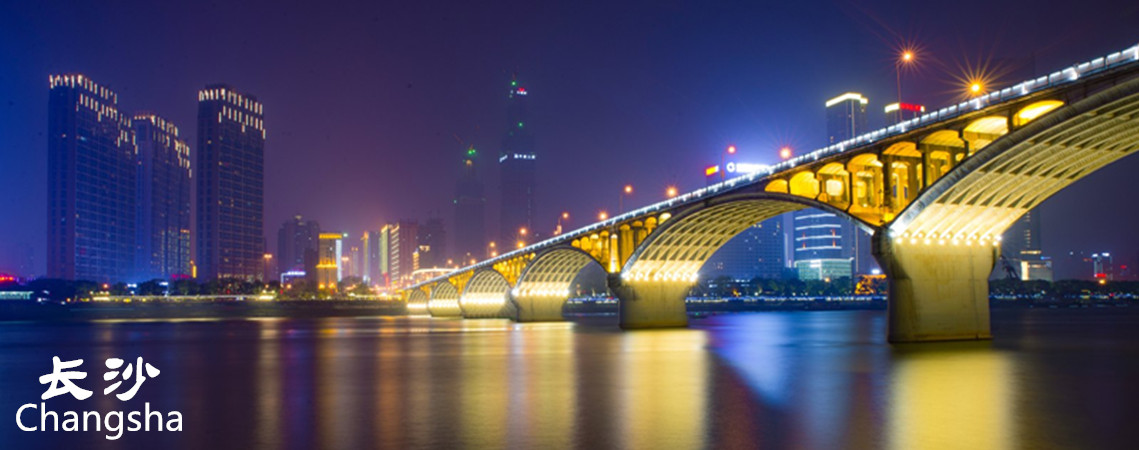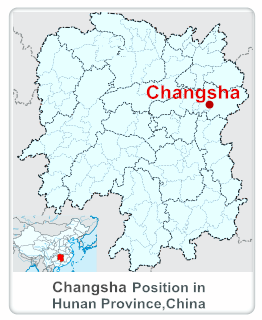
Changsha Overview
Changsha,capital of Hunan Province, is a famous ancient city with a history of 3,500 years. Nowadays, Changsha is an important place gathering historical and cultural relics, and a tourism collecting and distributing center of Hunan Province.People can still feel the past prosperity of the ancient city from a great  number of historical remains in the city.
number of historical remains in the city.
History of Changsha City
Culture of Changsha
Changsha Weather and Climate
Geography
Changsha City (east longitude111°53'~114°15', north latitude 27°51'~28°41'), is the capital city of Hunan Province. It is the political, economic, scientific, educational, cultural and business center of the province. It is located in the western margin of the Chang-Liu Basin and downstream of the Xiangjiang River.
To the east, Changsha's neighbors are Yichun City and Pingxiang City of Jiangxi Province. To its south sit Zhuzhou City and Xiangtan City, with Loudi City and Yiyang City in the west and Yueyang City and Yiyang City in the north.
The city of Changsha has direct jurisdiction over 5 districts, 1 county-level cities, and 3 counties:The length of the city from east to west is about 230 km, and the width from south to north is about 88 km. It covers an area of 11,819.5 square kilometers, of which the urban area occupies 948.23 square kilometers. The downtown area comprises 242.78 square kilometers.
History of Changsha
Changsha used to be a place of strategic importance of the state of Chu, a famous prefecture of the Qin Dynasty (221 – 207 B.C.), and the capital of the early Han Dynasty (206 B. C. – A.D. 220). A woman corpse that had been sunk in sleep for more than 2,000 years astonished the world along with the discovery of over 3,000 precious cultural relics excavated from the Han tombs at Mawangdui, making people in the world gasp in admiration at the advanced civilization created by the ancient people in Hunan.
Population of Changsha
According to the 2008 census, the total population of Changsha is 6,417,367. The downtown population was 2,365,801 individuals, among whom 408,441 are in Furong district, 412,586 in Tianxin district, 617,889 in Yuelu district, 411,404 in Kaifu district, and 515,499 in Yuhua district. Outside of the downtown, there are an additional 4,051,566 people living in Changsha county. They are distributed as follows: 775,815 in Changsha county, 541,622 in Wangcheng county, 1,353,826 in Ningxiang county and 1,380,303 in Liuyang city.In all of Changsha, there are 3,274,848 males and 3,142,519 females. The sex ratio (the ratio of males to females in a population) is 110.14:100.
Changsha is a multi-ethnic city. Fifty-three minority groups are represented in the city with a total population of 72,500. The largest ethnic groups in Changsha are the Tujia, Miao, Hui, Dong, Yao, Man and Zhuang. In addition, 50,000 more members of ethnic minority groups visit Changsha each year for business and tourism. These visitors include Uyghurs from Xinjiang; Zhuang and Qiang from Sichuan; Hui from Qinghai, Ningxia, Gansu, Shandong, Henan and Yunnan; Zhuang from Guangxi and Muslims from the Middle East. Changsha’s ethnic minority population is diverse and growing, and its members are scattered throughout the city. Furthermore, Changsha’s universities and colleges attract about 40,000 students from various ethnic minorities.
Hanhui Village, located in Laodaohe County of Kaifu District, is a multiethnic community in the city of Changsha. It was named a Model Unit for national unity by the State Council of the PRC in 1994. There are 338 households with a population of 1,253, one-third of whom are from the Hui nationality. There are over 40 Muslim enterprises of different sizes in Changsha’s halal food industry, and 12 of them were awarded the halal brand by the Provincial Government. For instance, there is one halal refrigerated storage center, two halal slaughter houses, and one halal food store. Altogether, the Muslim food enterprises occupy about 10, 000 square meters of commercial real estate.
There are two cemeteries for the Muslims in Changsha with a total area of 130 mu, one Muslim mosque of 5.95 mu with more than 2,000 square meters of building space.
Changsha Tourism
Changsha has given birth to a great number of celebrites. It is very hard to calculate how many famous historical ersonages once stayed in the city. in modern times alone, several dozen revolutionaries, including Mao Zedong and Liu Shaoqi, once studied, lived and fought in Changsha, Hunan First Normal College, the meeting venue of the Autumn Harvest Upstring, Qingshui Pool and other historical sites keep telling tourists the old stories. How can men of letters and celebrates be away from beautiful scenery? Yuelu Mountain which is pregnant with beauty and vitality, the Xiangjiang River that flows around the city, Orange Island which quietly lies in the middle of the river like a dragon, and other scenic and historic interest places in Changsha are jointly composing a melodious song.







 Ask Questions ?
Ask Questions ?